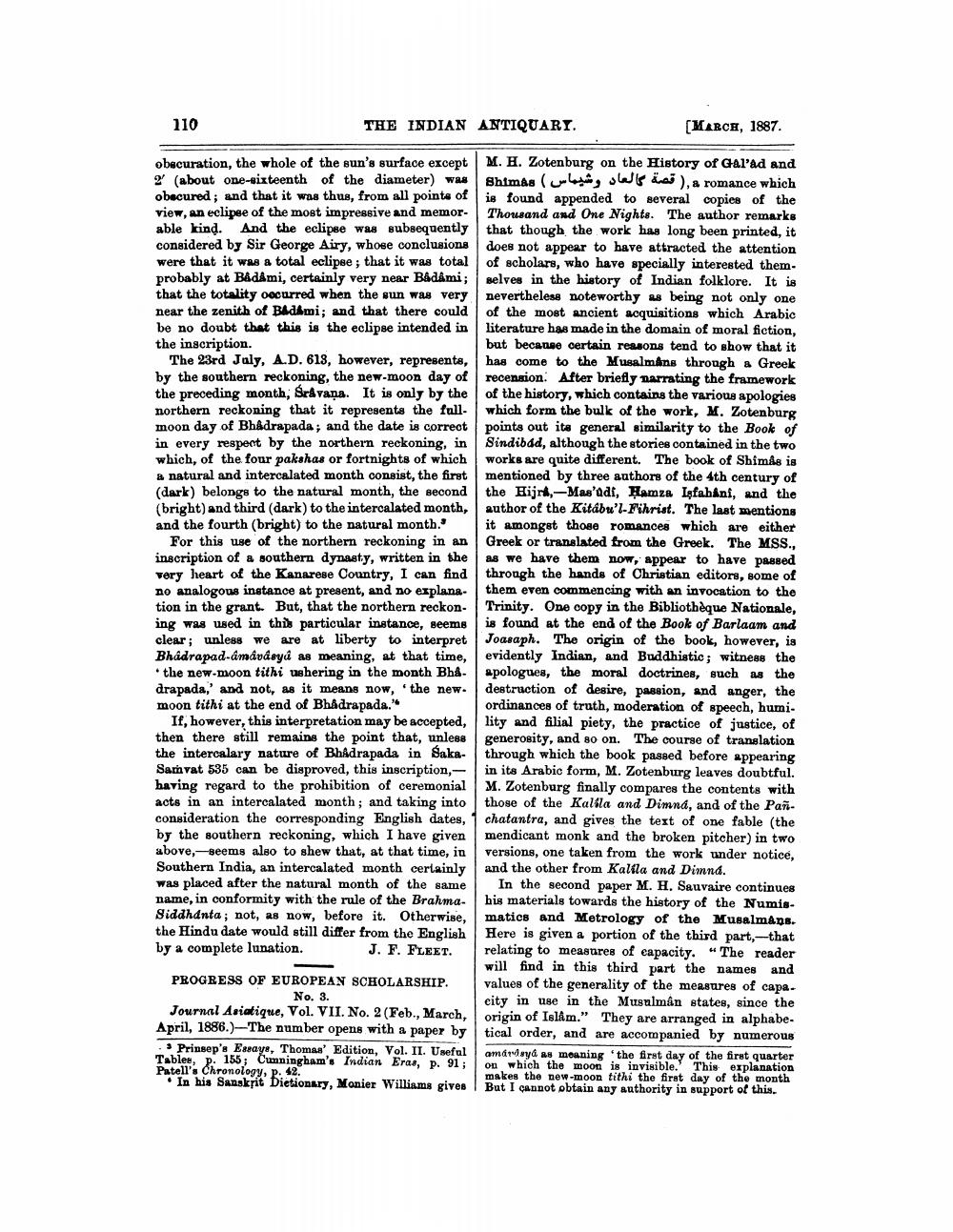________________
110
THE INDIAN ANTIQUARI.
(MARCH, 1887
obscuration, the whole of the sun's surface except | M. H. Zotenburg on the History of Gal'ad and 2 (about one-sixteenth of the diameter) was Shimas (uwag swisiei), a romance which obscured; and that it was thus, from all points of is found appended to several copies of the view, an eclipee of the most impressive and memor- Thousand and One Nights. The author remarks able kind. And the eclipse was subsequently that though the work has long been printed, it considered by Sir George Airy, whose conclusions does not appear to have attracted the attention were that it was a total eclipse; that it was total of scholars, who have specially interested them. probably at Badami, certainly very near Badami; selves in the history of Indian folklore. It is that the totality occurred when the sun was very nevertheless noteworthy as being not only one near the zenith of Badami; and that there could of the most ancient acquisitions which Arabic be no doubt that this is the eclipse intended in literature has made in the domain of moral fiction, the inscription.
but because certain reasons tend to show that it The 23rd Jaly, A.D. 613, however, represents, has come to the Musalmans through a Greek by the southern reckoning, the new-moon day of recensionAfter briefly narrating the framework the preceding month, Sravana. It is only by the of the history, which contains the various apologies northern reckoning that it represents the full- which form the bulk of the work, M. Zotenburg moon day of Bhadrapada; and the date is correct points out its general similarity to the Book of in every respect by the northern reckoning, in Sindibdd, although the stories contained in the two which, of the four pakshas or fortnights of which works are quite different. The book of Shimas is a natural and intercalated month consist, the first mentioned by three authors of the 4th century of (dark) belongs to the natural month, the second the Hijri-Mas'adi, Hamza Isfahani, and the (bright) and third (dark) to the intercalated month, author of the Kitabu'l-Fihrist. The last mentions and the fourth (bright) to the natural month" it amongst those romances which are either
For this use of the northern reckoning in an Greek or translated from the Greek. The MSS., inscription of a southern dynasty, written in the as we have them now, appear to have passed very heart of the Kanarese Country, I can find through the hands of Christian editors, some of no analogow instance at present, and no explana- them even commencing with an invocation to the tion in the grant. But, that the northern reckon- Trinity. One copy in the Bibliothèque Nationale, ing was used in this particular instance, seems is found at the end of the Book of Barlaam and clear; unless we are at liberty to interpret Joasaph. The origin of the book, however, is Bhadrapad-amdvdsyd as meaning, at that time, evidently Indian, and Buddhistic; witness the * the new-moon tithi wehering in the month Bhd. apologues, the moral doctrines, such as the drapada,' and not, as it means now, the new destruction of desire, passion, and anger, the moon tithi at the end of Bhadrapada."
ordinances of truth, moderation of speech, humi. If, however, this interpretation may be accepted, lity and filial piety, the practice of justice, of then there still remains the point that, unless generosity, and so on. The course of translation the intercalary nature of Bhådrapada in Saka- through which the book passed before appearing Samvat 535 can be disproved, this inscription,- in its Arabic form, M. Zotenburg leaves doubtful. having regard to the prohibition of ceremonial M. Zotenburg finally compares the contents with acts in an intercalated month; and taking into those of the Kalila and Dimná, and of the Panconsideration the corresponding English dates, 1 chatantra, and gives the text of one fable (the by the southern reckoning, which I have given mendicant monk and the broken pitcher) in two above, seems also to shew that, at that time, in versions, one taken from the work under notice, Southern India, an intercalated month certainly and the other from Kalila and Dimnd. was placed after the natural month of the same In the second paper M. H. Sauvaire continues name, in conformity with the rule of the Brahma- his materials towards the history of the NumisSiddhanta; not, as now, before it. Otherwise, matics and Metrology of the Musalmans. the Hindu date would still differ from the English Here is given a portion of the third part,--that by a complete lunation.
J. F. FLEET. relating to measures of capacity. "The reader
will find in this third part the names and PROGRESS OF EUROPEAN SCHOLARSHIP. values of the generality of the measures of capa. No. 3.
eity in use in the Musalman states, since the Journal Asiatique, Vol. VII. No. 2 (Feb., March, origin of Islam." They are arranged in alphabeApril, 1886.)--The number opens with a paper by tical order, and are accompanied by numerous . Prinsep's Essays, Thomas' Edition, Vol. II. Useful amarsya as meaning the first day of the first quarter Tablee, p. 155; Cunningham's Indian Eras, p. 91; on which the moon is invisible. This explanation Patell's Chronology, p. 42.
makes the new-moon tithi the first day of the month In his Sanskrit Dictionary, Monier Williams gives But I cannot obtain any authority in support of this




